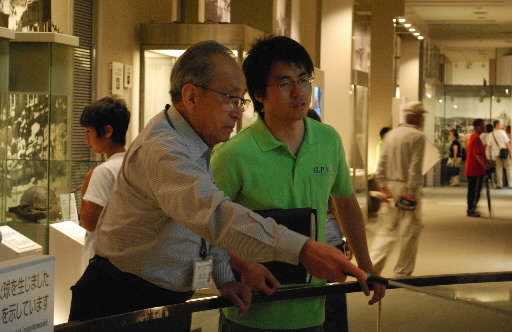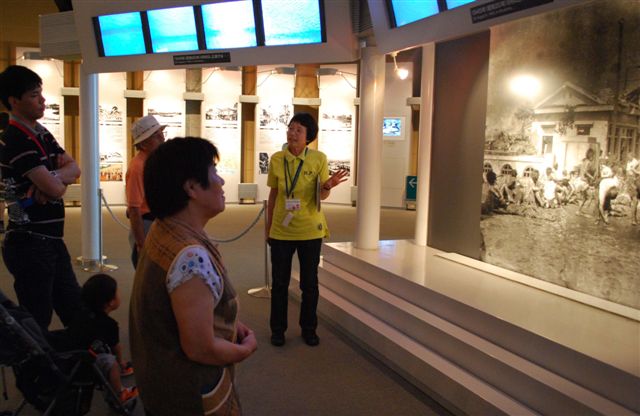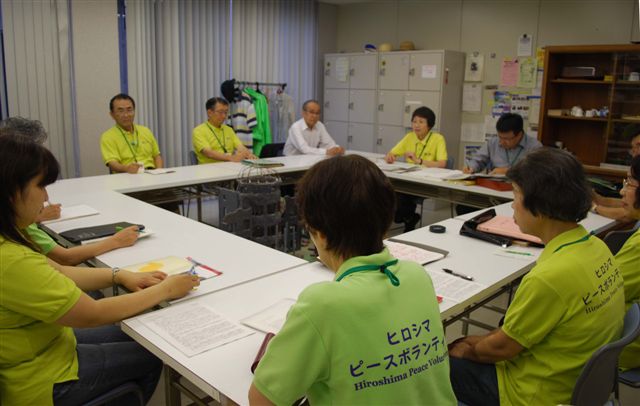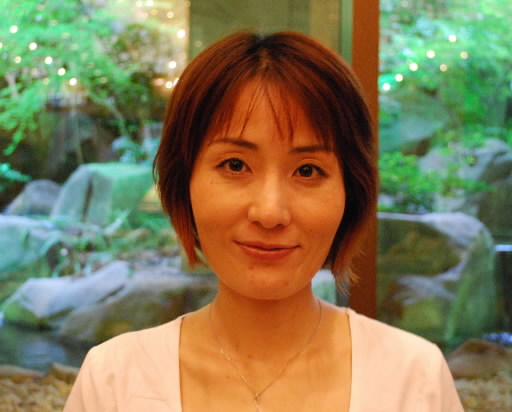Peace Museum volunteers mark 10th anniversary of group’s formation
Jul. 11, 2009
by Miho Kuwajima, Staff Writer
Ten years have passed since the formation of Hiroshima Peace Volunteers, whose members give tours of Hiroshima Peace Memorial Museum. The group has a membership of 210, including atomic bomb survivors, retirees, and young people. By attending seminars and participating in other activities, each of them has made efforts to address the issue of how to convey the message of Hiroshima. At their own initiative, they are also preparing a special publication to mark the group’s 10th anniversary.
Their carefully thought-out tours, which include the grounds of Peace Memorial Park, are for the most part popular with visitors, and the museum plans to enhance them. But the group’s volunteer spirit and motivation are what really keeps it going. The next challenge the group will have to tackle is how to further develop its system so as to carry on telling the stories of those who experienced the atomic bombing.
On the first floor of the east wing of the Peace Museum, where visitors enter, there are many exhibits related to Hiroshima’s history as a military town and the reasons behind the dropping of the atomic bomb by the United States. Many people pass quickly through this part of the museum, but when Peace Volunteers are present, it’s a different story.
Hiroko Usagawa, 63, stood in front of photographs depicting scenes in Hiroshima just after the bombing and began to describe one of them. Families and out-of-town visitors listened intently. “The woman whose back can be seen in this photograph walked frantically around the city, carrying her baby,” said Ms. Usagawa. “I was told that the photographer who took this picture couldn’t stop crying.”
Behind Ms. Usagawa, Kota Kiya, 68, who also serves as a volunteer guide on Mondays, began talking to another visitor. “There didn’t seem to be any effort at all to minimize casualties among ordinary citizens,” he said. “That’s how badly the U.S. wanted to demonstrate the power of the atomic bomb.” The man, who was visiting from Nagoya, gazed once again at the photo of a burned-out Hiroshima.
Speaking on behalf of her mother
“I would like visitors to consider what the items on display in the museum can tell them and to think about the bombing of Hiroshima as something that is not unrelated to their own lives,” Ms. Usagawa said. She started volunteering at the museum eight years ago on behalf of her mother, who died having said little about her experiences in the bombing.
Mr. Kiya said he focuses on describing Hiroshima’s pre- and post-war history. He uses the accounts of A-bomb survivors as well as literature about the bombing as the “textbook” for his tours. “There are lots of things we should read, such as Children of the Atomic Bomb by Arata Osada and books by Tamiki Hara,” he said.
Ms. Usagawa, Mr. Kiya, and the other members who volunteer on Mondays always have a voluntary study session at the end of the day. The group uses materials put together by Kenichi Harada, 64, who has been a volunteer since 2000. The materials include questions from visitors to the volunteers, such as why the framework of the Atomic Bomb Dome didn’t melt and how many people near the hypocenter of the bombing survived. Mr. Harada’s “Monday Memo” is based on those questions as well as exchanges of information between the volunteers themselves. He sends this information out to the other members of the group via e-mail each week.
A native of Hyogo Prefecture, Mr. Harada has lived in Hiroshima since being transferred here by his company. He decided to become a volunteer because he wanted to learn more about the bombing. He also wanted to make use of the English language skills he acquired while living in the U.S. for five years. At the end of June he put out the 475th edition of the “Monday Memo.”
Last year Yang Xiaoping, 27, a Chinese resident of Higashi Hiroshima City, also joined the Monday group. Mr. Yang came to Hiroshima in the fall of 2006 to study at Hiroshima University’s graduate school. Like Mr. Harada, he became a volunteer because he wanted to learn more about the bombing.
Whenever Mr. Yang conducts tours, he carries with him a file full of newspaper clippings and descriptions of the monuments in the park. “Even many Japanese people know very little about the history of the atomic bombing,” he said. “As a student living in Hiroshima Prefecture, I’d like to tell others about what happened here.”
“Nationality is irrelevant”
When Mr. Yang did not know how to answer a question from a visitor, Hiroshi Hosokawa, 81, and other guides quietly stepped in to assist. “He is working really hard to learn everything he can about Hiroshima. Nationality is irrelevant when it comes to telling the story of the atomic bombing,” Mr. Hosokawa said.
Many Chinese visitors object to the way history is portrayed in the museum. “When I explain it to them in Chinese, most of them accept my explanation,” Mr. Yang said. “I want to be a bridge between Hiroshima and China. It would be nice if there were more foreign volunteers.” He said the museum should also better publicize the role of the guides so they can have more contact with visitors from overseas.
In 1999, when the Peace Volunteers group was established, there were 58 members. Today there are 210. Ranging in age from 21 to 82, they are divided into smaller groups, one for each day of the week. Every day they conduct tours of the museum and the park from 10:30 a.m. to 3 p.m. They are paid travel expenses for two trips to the museum a month.
According to Minoru Hataguchi, 63, the museum’s former director, with school trips being taken to a greater variety of destinations, the annual number of visitors to the museum has declined since reaching its peak at 1,554,897 in 1995, which marked the 50th year of the atomic bombing. In order to boost the number of visitors, the museum decided to create the volunteer system to ensure that the stories of survivors of the bombing would continue to be told and to incorporate the desires and opinions of museum visitors.
Initially, the volunteers were limited to describing the basics of the damage inflicted by the bombing, but their duties were expanded in response to the requests of museum visitors. At present, the volunteers provide explanations of exhibitions that interest them and also show visitors the monuments in Peace Memorial Park.
The volunteers are divided into groups according to the days they are assigned to serve. Each day the volunteers on duty hold meetings in the morning and evening to discuss things they have noticed about the exhibitions or that have been pointed out by visitors. Employees of the museum sit in on the meetings, but some volunteers have complained that their views are not reflected in the museum’s operations.
The guides have no official manual. They simply make their own as they see fit. The museum used to conduct an orientation session for new volunteers, but because of budget cuts, starting this year it was combined with a peace study program offered to the public by the Hiroshima Peace Culture Foundation.
Kaori Nakatsuka, 33, who became a volunteer last year, expressed concern. “Visitors from overseas often ask me about the history of the war, but I can only reply based on what I’ve studied myself,” she said.
Others have pointed out that with the increase in the number of volunteers, visitors are sometimes unhappy when they want to tour the museum alone and are nevertheless approached by volunteers.
“We have relied on volunteer spirit and been guided by what they have done in the past,” said Koichiro Maeda, 60, the museum’s director. “I would like to consider improving the system by establishing minimal criteria and standards.” He said he would also like to create an opportunity for the voices of volunteers to be heard by the panel of outside experts that is discussing changes to the museum’s exhibitions.
The Peace Volunteers are given free admission to the museum, and a break room is provided for their use. Keiko Ogura, 71, who has been giving tours of Peace Memorial Park at her own initiative for 25 years, suggested creating more opportunities to answer visitors’ questions in the break room and to talk with other volunteers.
Systematic cooperation needed
It’s significant that the volunteers’ explanations differ depending on their interpretation of the dropping of the atomic bomb and their personal feelings about it. Museum visitors encounter various aspects of Hiroshima’s experience as a result. But a training system to give volunteers basic facts about the bombing, including the history of the Asia-Pacific War, is essential.
Peace Memorial Museum is inadequate in many ways, such as the issue of atomic bomb survivors living overseas and the meaning of items that belonged to victims. The museum needs to reassess the current situation and create a mechanism for cooperation with the volunteers.
If basic elements are not systematized and things are left up to the volunteer spirit, the museum cannot fulfill its duty to convey the message of Hiroshima.
Before the Peace Volunteer system was established, atomic bomb survivors and other citizens gave tours of the museum and the park. Why not create a dual system by opening the door to various volunteer organizations and at the same time training part-time tour guides who would work in a capacity similar to curators? The museum should also take a look at what museums overseas are doing.
(Originally published on July 6, 2009)
To comment on this article, please click the link below. Comments will be moderated and posted in a timely fashion. Comments may also appear in the Chugoku Shimbun newspaper.
Ten years have passed since the formation of Hiroshima Peace Volunteers, whose members give tours of Hiroshima Peace Memorial Museum. The group has a membership of 210, including atomic bomb survivors, retirees, and young people. By attending seminars and participating in other activities, each of them has made efforts to address the issue of how to convey the message of Hiroshima. At their own initiative, they are also preparing a special publication to mark the group’s 10th anniversary.
Their carefully thought-out tours, which include the grounds of Peace Memorial Park, are for the most part popular with visitors, and the museum plans to enhance them. But the group’s volunteer spirit and motivation are what really keeps it going. The next challenge the group will have to tackle is how to further develop its system so as to carry on telling the stories of those who experienced the atomic bombing.
On the first floor of the east wing of the Peace Museum, where visitors enter, there are many exhibits related to Hiroshima’s history as a military town and the reasons behind the dropping of the atomic bomb by the United States. Many people pass quickly through this part of the museum, but when Peace Volunteers are present, it’s a different story.
Hiroko Usagawa, 63, stood in front of photographs depicting scenes in Hiroshima just after the bombing and began to describe one of them. Families and out-of-town visitors listened intently. “The woman whose back can be seen in this photograph walked frantically around the city, carrying her baby,” said Ms. Usagawa. “I was told that the photographer who took this picture couldn’t stop crying.”
Behind Ms. Usagawa, Kota Kiya, 68, who also serves as a volunteer guide on Mondays, began talking to another visitor. “There didn’t seem to be any effort at all to minimize casualties among ordinary citizens,” he said. “That’s how badly the U.S. wanted to demonstrate the power of the atomic bomb.” The man, who was visiting from Nagoya, gazed once again at the photo of a burned-out Hiroshima.
Speaking on behalf of her mother
“I would like visitors to consider what the items on display in the museum can tell them and to think about the bombing of Hiroshima as something that is not unrelated to their own lives,” Ms. Usagawa said. She started volunteering at the museum eight years ago on behalf of her mother, who died having said little about her experiences in the bombing.
Mr. Kiya said he focuses on describing Hiroshima’s pre- and post-war history. He uses the accounts of A-bomb survivors as well as literature about the bombing as the “textbook” for his tours. “There are lots of things we should read, such as Children of the Atomic Bomb by Arata Osada and books by Tamiki Hara,” he said.
Ms. Usagawa, Mr. Kiya, and the other members who volunteer on Mondays always have a voluntary study session at the end of the day. The group uses materials put together by Kenichi Harada, 64, who has been a volunteer since 2000. The materials include questions from visitors to the volunteers, such as why the framework of the Atomic Bomb Dome didn’t melt and how many people near the hypocenter of the bombing survived. Mr. Harada’s “Monday Memo” is based on those questions as well as exchanges of information between the volunteers themselves. He sends this information out to the other members of the group via e-mail each week.
A native of Hyogo Prefecture, Mr. Harada has lived in Hiroshima since being transferred here by his company. He decided to become a volunteer because he wanted to learn more about the bombing. He also wanted to make use of the English language skills he acquired while living in the U.S. for five years. At the end of June he put out the 475th edition of the “Monday Memo.”
Last year Yang Xiaoping, 27, a Chinese resident of Higashi Hiroshima City, also joined the Monday group. Mr. Yang came to Hiroshima in the fall of 2006 to study at Hiroshima University’s graduate school. Like Mr. Harada, he became a volunteer because he wanted to learn more about the bombing.
Whenever Mr. Yang conducts tours, he carries with him a file full of newspaper clippings and descriptions of the monuments in the park. “Even many Japanese people know very little about the history of the atomic bombing,” he said. “As a student living in Hiroshima Prefecture, I’d like to tell others about what happened here.”
“Nationality is irrelevant”
When Mr. Yang did not know how to answer a question from a visitor, Hiroshi Hosokawa, 81, and other guides quietly stepped in to assist. “He is working really hard to learn everything he can about Hiroshima. Nationality is irrelevant when it comes to telling the story of the atomic bombing,” Mr. Hosokawa said.
Many Chinese visitors object to the way history is portrayed in the museum. “When I explain it to them in Chinese, most of them accept my explanation,” Mr. Yang said. “I want to be a bridge between Hiroshima and China. It would be nice if there were more foreign volunteers.” He said the museum should also better publicize the role of the guides so they can have more contact with visitors from overseas.
Reliance on volunteers, lack of manual or training
In 1999, when the Peace Volunteers group was established, there were 58 members. Today there are 210. Ranging in age from 21 to 82, they are divided into smaller groups, one for each day of the week. Every day they conduct tours of the museum and the park from 10:30 a.m. to 3 p.m. They are paid travel expenses for two trips to the museum a month.
According to Minoru Hataguchi, 63, the museum’s former director, with school trips being taken to a greater variety of destinations, the annual number of visitors to the museum has declined since reaching its peak at 1,554,897 in 1995, which marked the 50th year of the atomic bombing. In order to boost the number of visitors, the museum decided to create the volunteer system to ensure that the stories of survivors of the bombing would continue to be told and to incorporate the desires and opinions of museum visitors.
Initially, the volunteers were limited to describing the basics of the damage inflicted by the bombing, but their duties were expanded in response to the requests of museum visitors. At present, the volunteers provide explanations of exhibitions that interest them and also show visitors the monuments in Peace Memorial Park.
The volunteers are divided into groups according to the days they are assigned to serve. Each day the volunteers on duty hold meetings in the morning and evening to discuss things they have noticed about the exhibitions or that have been pointed out by visitors. Employees of the museum sit in on the meetings, but some volunteers have complained that their views are not reflected in the museum’s operations.
The guides have no official manual. They simply make their own as they see fit. The museum used to conduct an orientation session for new volunteers, but because of budget cuts, starting this year it was combined with a peace study program offered to the public by the Hiroshima Peace Culture Foundation.
Kaori Nakatsuka, 33, who became a volunteer last year, expressed concern. “Visitors from overseas often ask me about the history of the war, but I can only reply based on what I’ve studied myself,” she said.
Others have pointed out that with the increase in the number of volunteers, visitors are sometimes unhappy when they want to tour the museum alone and are nevertheless approached by volunteers.
“We have relied on volunteer spirit and been guided by what they have done in the past,” said Koichiro Maeda, 60, the museum’s director. “I would like to consider improving the system by establishing minimal criteria and standards.” He said he would also like to create an opportunity for the voices of volunteers to be heard by the panel of outside experts that is discussing changes to the museum’s exhibitions.
The Peace Volunteers are given free admission to the museum, and a break room is provided for their use. Keiko Ogura, 71, who has been giving tours of Peace Memorial Park at her own initiative for 25 years, suggested creating more opportunities to answer visitors’ questions in the break room and to talk with other volunteers.
Interview with Akiko Naono, Associate Professor, Graduate School of Kyushu University
Systematic cooperation needed
It’s significant that the volunteers’ explanations differ depending on their interpretation of the dropping of the atomic bomb and their personal feelings about it. Museum visitors encounter various aspects of Hiroshima’s experience as a result. But a training system to give volunteers basic facts about the bombing, including the history of the Asia-Pacific War, is essential.
Peace Memorial Museum is inadequate in many ways, such as the issue of atomic bomb survivors living overseas and the meaning of items that belonged to victims. The museum needs to reassess the current situation and create a mechanism for cooperation with the volunteers.
If basic elements are not systematized and things are left up to the volunteer spirit, the museum cannot fulfill its duty to convey the message of Hiroshima.
Before the Peace Volunteer system was established, atomic bomb survivors and other citizens gave tours of the museum and the park. Why not create a dual system by opening the door to various volunteer organizations and at the same time training part-time tour guides who would work in a capacity similar to curators? The museum should also take a look at what museums overseas are doing.
(Originally published on July 6, 2009)
To comment on this article, please click the link below. Comments will be moderated and posted in a timely fashion. Comments may also appear in the Chugoku Shimbun newspaper.











